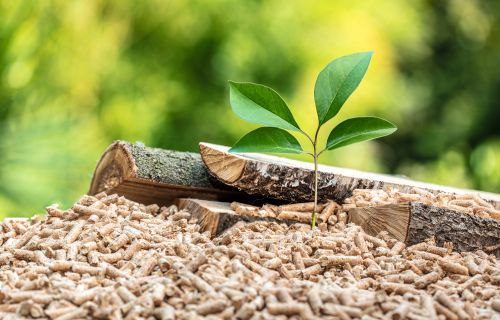Cenne odpady - krótki poradnik jak wykorzystać surowce

Niezależnie czy prowadzisz mały warsztat, zakład przetwórczy, tartak czy gospodarstwo rolne - jedno jest pewne: twoja praca generuje odpady. Ich odprowadzenie i utylizacja to przykry i nierzadko kosztowny obowiązek, obwarowany trudnymi do spełnienia przepisami. Przemyślane zarządzanie odpadami może jednak sprawić, że na przysłowiowych “śmieciach” można sporo zaoszczędzić, a nawet… zarobić.
Przyjrzyjmy się temu bliżej.
Jak zamienić odpady w paliwo? - produkcja opału z biomasy
Biomasa - co to?
Biomasa to - najkrócej ujmując - biodegradowalny odpad produkcji rolnej pochodzenia roślinnego lub zwierzęcego. W praktyce oznacza to wszelkiego rodzaju ścinki, obierki, wióry, trociny i tym podobne resztki z procesu przetwórczego. Tego rodzaju odpady posiadają duży potencjał energetyczny, który można uwolnić dość niewielkim kosztem. Wynika to z faktu, że wszelkiego rodzaju rośliny podczas swojego wzrostu pobierają energię ze Słońca. W procesie spalania ta energia może zostać uwolniona.
Rodzaje paliw z biomasy
Brykiety
Jednym z najprostszych sposobów spożytkowania biomasy jest brykietowanie. Proces ten polega na zmieleniu, a następnie sprasowaniu odpadu pochodzenia naturalnego. Urządzeniem do tego celu niezbędnym jest brykieciarka. Produkcja brykietu polega na wytwarzaniu we wnętrzu brykieciarki wysokiego ciśnienia, które łączy cząstki materiału, tworząc trwałe, łatwe do przechowywania i transportu brykiety paliwowe.
Gotowy opał najczęściej ma formę niewielkich prostopadłościanów. Do materiałów nadających się do produkcji brykietów zaliczamy: trociny, słomę, liście, trawę, odpady tartaczne, łuski zbóż, łodygi roślin, niewykorzystane w przetwórstwie części roślin, owoców lub warzyw. Wartość energetyczna brykietów może się różnić w zależności od rodzaju biomasy, wilgotności materiału oraz sposobu jego przetworzenia. Najbardziej energetyczny: brykiet z trocin, posiada wydajność na poziomie 17 - 19 MJ/kg.
Brykiety są paliwem dość uniwersalnym jeśli chodzi o wymagane do ich użytkowania zaplecze sprzętowe. Najlepszą wydajność osiągają w piecach na biomasę, lecz spalają się bezproblemowo także w kotłach uniwersalnych, piecach węglowych z regulowanym dopływem powietrza czy w kotłach przemysłowych. Rzadziej, ale także z powiedzeniem, pali się nimi w komikach lub tzw. “kozach”.
Pellet
Bardziej specjalistycznym i zbilansowanym rodzajem paliwa produkowanego z biomasy jest pellet. Ten typ opału wytwarza się głównie z odpadów drewnopochodnych - wszelkiego rodzaju wiórów, trocin, zrębków czy gałęzi przepuszczonych uprzednio przez rębak do drewna. Nieco mniejszy niż w przypadku brykietów wachlarz możliwości przekłada się też na liczne zalety pelletu - przede wszystkim wydajność i małą produkcję dymu i popiołu. Dobrej jakości pellet wykazuje wartość energetyczną 18 - 20 MJ/kg.
Produkcja pelletu odbywa się we wnętrzu maszyny zwanej pelleciarką. Podobnie jak w przypadku brykietowania, materiał początkowy zostaje zmielony i poddany sprasowaniu pod wysokim ciśnieniem. Dzięki temu w procesie nie jest potrzebne sztuczne lepiszcze.
Gotowy pellet przybiera formę walcowatych granulek o średnicy zazwyczaj nieprzekraczającej 1,5 cm.
Ta sypka forma ułatwia transport, a przede wszystkim dozowanie opału, zwłaszcza w zautomatyzowanych piecach wyposażonych w podajnik ślimakowy. Pellet przeznaczony jest do użytkowania w specjalnych piecach, wyposażonych w palnik na pellet. Spala się wytwarzając małe ilości dymu i popiołu, gdyż jest mniej wilgotny niż drewno czy brykiety mieszane.
Pellet jest nowoczesnym rozwiązaniem grzewczym, które doskonale sprawdzi się w domach jednorodzinnych. Dobrze skonfigurowany piec na pellet pozwala wykorzystać maksimum potencjału energetycznego opału, a zyskujące na popularności inteligentne rozwiązania ułatwiają automatyczne dozowanie pelletu, nawet na odległość - z użyciem smartfona.
Produkcja paliw z biomasy - opłacalna i ekologiczna
Zalety produkcji paliw z biomasy można mnożyć.
Produkcja paliw z biomasy jest rozwiązaniem ekologicznym, ponieważ biomasa, w przeciwieństwie do paliw kopalnych, pochłania dwutlenek węgla (CO₂) w trakcie wzrostu roślin, a podczas spalania wydziela go z powrotem do atmosfery. Z tego powodu cykl węglowy biomasy jest niemal neutralny, co pomaga w redukcji ogólnej emisji gazów cieplarnianych.
Dodatkowo, biomasa jest odnawialnym źródłem energii, ponieważ rośliny mogą być uprawiane w krótkim czasie, co sprawia, że produkcja paliw z biomasy jest zrównoważona i nie wyczerpuje zasobów naturalnych. Produkcja takich paliw pozwala także na wykorzystanie odpadów rolniczych, leśnych czy przemysłowych. W ten sposób można zapobiec marnotrawstwu, którego chyba nikt z nas nie lubi.
Produkcja własnego paliwa może pozwolić także na oszczędności a w przypadku nadprodukcji opału - nawet zarobek. Warto pamiętać jednak, że aby legalnie sprzedawać opał z biomasy wymaga się od producenta spełnienia pewnych wymogów prawnych, w tym często uzyskania odpowiednich zezwoleń i spełnienia norm jakościowych.













